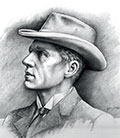AB ‘Banjo’ Paterson (1864–1941)

Poet, ballad writer, journalist and horseman.
1864: AB ‘Banjo’ Paterson, known as Barty to his family, was born Andrew Barton Paterson at Narrambla, near Orange, on 17 February 1864. His parents, Andrew Bogle and Rose Isabella Paterson, were graziers on Illalong station in the Yass district. Paterson's early education took place at home under a governess and then at the bush school in Binalong, the nearest township.
1874: From about the age of 10 he attended Sydney Grammar School. He lived with his grandmother in Gladesville and spent the school holidays at Illalong station with his family.
1880: After completing school, the 16-year-old Paterson was articled to a Sydney firm of solicitors, Spain and Salway.
1886: He was admitted as a solicitor and formed the legal partnership, Street and Paterson. During these years Paterson began publishing verse in the Bulletin and Sydney Mail under the pseudonyms ‘B’ and ‘The Banjo’.
1895: At the age of 31 and still in partnership with Street, Paterson achieved two milestones in Australian writing. He composed his now famous ballad ‘Waltzing Matilda’ and his first book, The Man from Snowy River, and other verses, was published by Angus & Robertson, marking the beginning of an epoch in Australian publishing. This hallmark publication sold out its first edition within a week and went through four editions in six months, making Paterson second only to Kipling in popularity among living poets writing in English. His poetry continues to sell well today and is available in many editions.
1899: Paterson travelled to South Africa as special war correspondent for The Sydney Morning Herald during the Boer War, and to China in 1901 with the intention of covering the Boxer Rebellion but he arrived after the uprising was over.
1902: Paterson left the legal profession to become a journalist.
1903: Married Alice Walker in Tenterfield. Their first home was in Queen Street, Woollahra. The Patersons had two children, Grace born in 1904 and Hugh born in 1906.
1903–1906: He was editor of the Evening News (Sydney).
1907–1908 He was the editor of Town and Country Journal.
1908: He moved back to the country to take over a property in Coodra Vale, near Wee Jasper.
1914–1918: During World War I, Paterson sailed to Europe hoping for an appointment as a war correspondent. Instead, during the course of the war he was attached as an ambulance driver to the Australian Voluntary Hospital in France and was commissioned to the 2nd Remount Unit of the Australian Imperial Force. He was eventually promoted to Major.
1919: Upon his return to Australia, Paterson resumed journalism.
1923: Publication of The Collected Verse of A.B. Paterson.
1930: Paterson retired from journalism.
1933: Publication of a book for children, The Animals Noah Forgot.
1939: He was appointed Commander of the Order of the British Empire.
1941: At the time of his death on 5 February 1941 his reputation as the principal folk poet of Australia was secure. His body of work included seven volumes of poetry and prose in many editions, in addition to his many pieces of journalism and reportage.
Further information is available in Notable Australians.